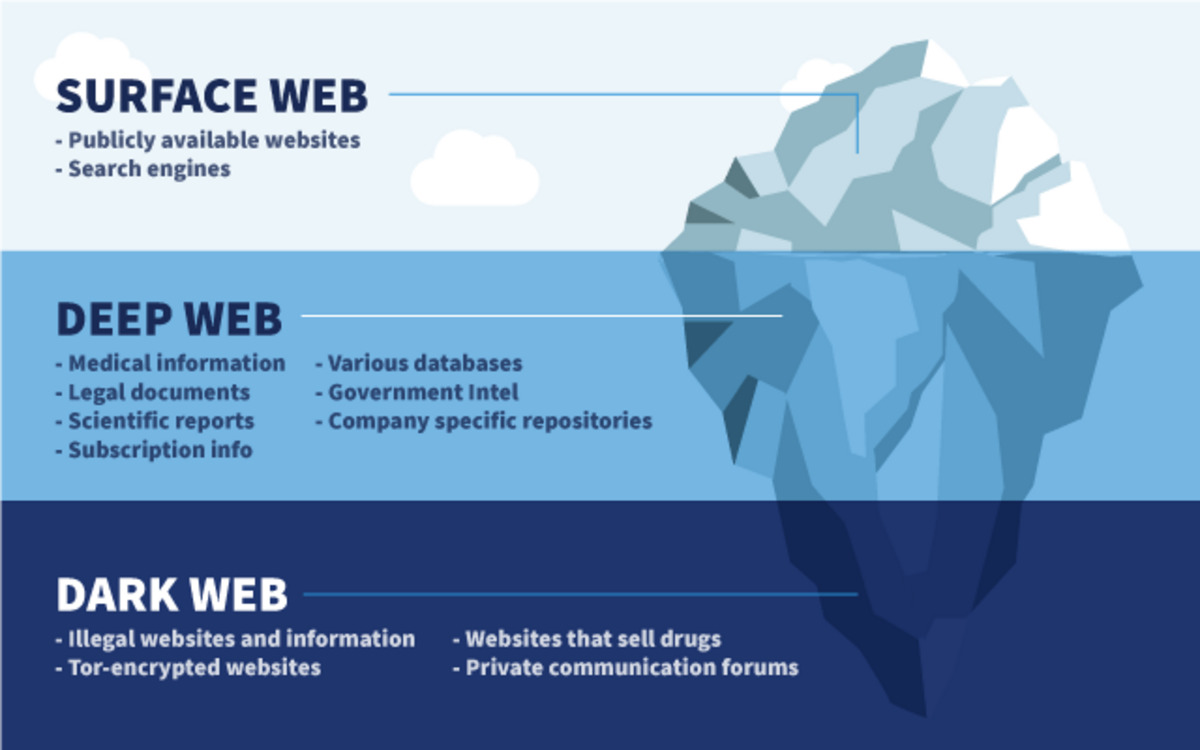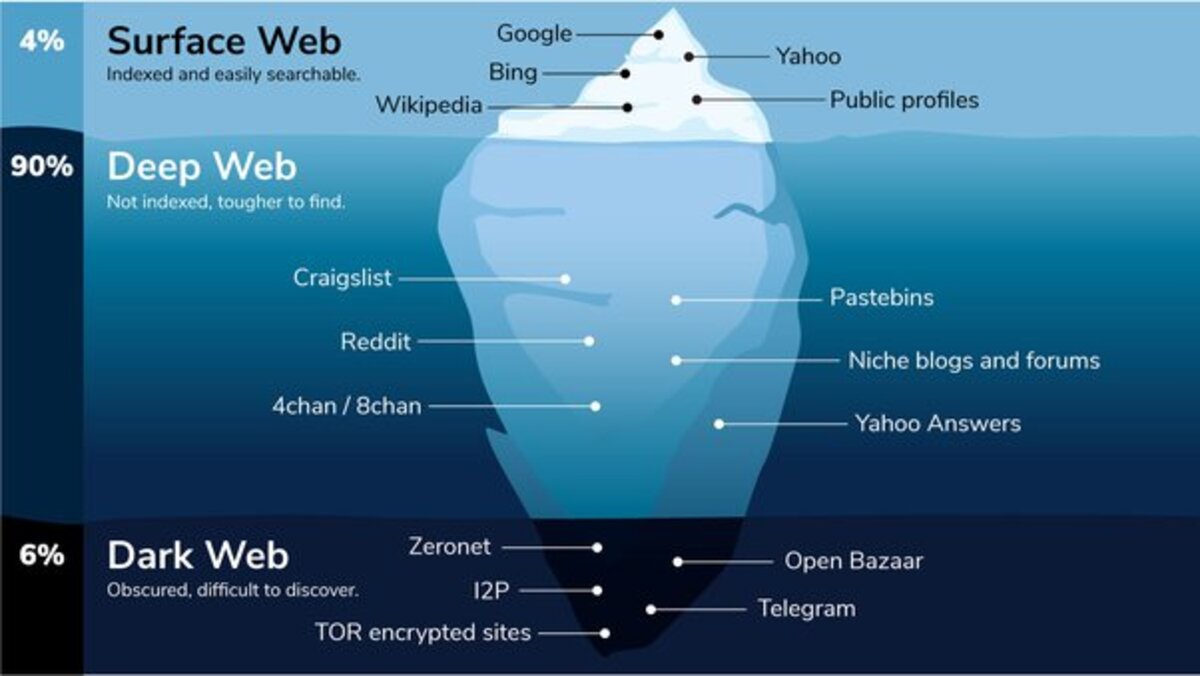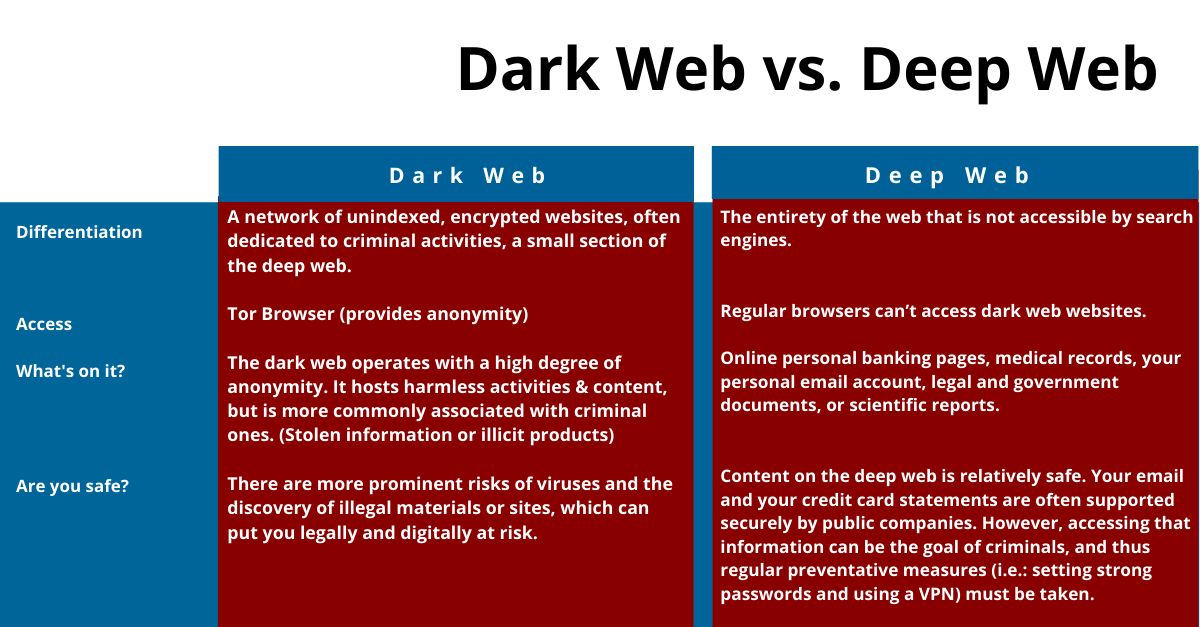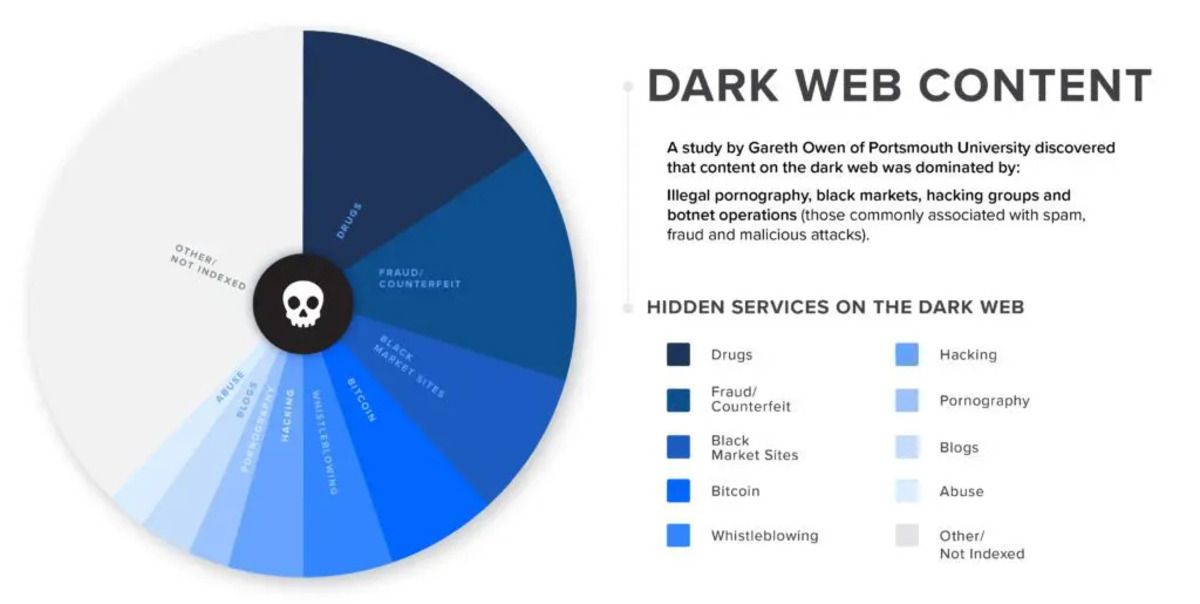Introduction
Welcome to the vast and mysterious realm of the internet. Well, not the part you’re used to – the one you can access with a simple search or by typing in a web address. We’re talking about the Deep Web and Dark Web – the hidden corners of the internet that often elude casual internet users.
While you may be familiar with the websites, forums, and social media platforms you visit regularly, there’s a whole other world out there that remains concealed from traditional search engines. This hidden part of the internet holds a wealth of information, ranging from legitimate databases to more clandestine networks.
In this article, we’ll explore what exactly the Deep Web and Dark Web are, how they differ from the Surface Web, how to access them, their purposes, and some of the concerns and controversies surrounding these hidden realms.
So, buckle up and get ready to delve into the depths of the internet – where anonymity, secrecy, and privacy take on a whole new meaning.
What is the Deep Web?
The Deep Web refers to the part of the internet that is not indexed by search engines like Google, Bing, or Yahoo. It is estimated that the Deep Web is significantly larger than the Surface Web, which is the portion of the internet that most people use on a daily basis. Unlike the Surface Web, which consists of websites that are easily accessible and indexed by search engines, the Deep Web consists of content that is hidden behind passwords, paywalls, or other forms of access restrictions.
One analogy often used to describe the Deep Web is an iceberg. The Surface Web, the part that can be easily seen and accessed, is just the tip of the iceberg. Beneath the surface lies a vast, interconnected network of databases, private networks, and other resources that are not accessible through traditional search engines.
The Deep Web is home to a wide range of content, including academic databases, scientific research, government resources, private intranets, confidential business information, and much more. These parts of the internet are not necessarily hidden due to nefarious purposes but rather require special access or permissions to protect sensitive information or maintain privacy.
While the Deep Web is often associated with illicit activities, it is important to note that not all content in the Deep Web is illegal or malicious. In fact, a significant portion of it is legitimate and valuable. Researchers, journalists, and other professionals often rely on the Deep Web to access important information that is not accessible through traditional search engines.
It’s essential to understand that the Deep Web is not synonymous with the Dark Web, which we will delve into later. The Deep Web primarily consists of content that is merely unindexed, while the Dark Web refers to a hidden network within the Deep Web that requires special software or configurations to access. It’s important not to confuse or conflate these terms because they represent distinct aspects of the hidden internet.
The Hidden Layers of the Internet
When you think of the internet, most likely images of websites, social media platforms, and online shopping come to mind. However, what many people don’t realize is that these visible parts of the internet, often referred to as the Surface Web, make up only a small fraction of what the internet truly encompasses.
Beneath the Surface Web lies a series of hidden layers, each with its own level of accessibility and anonymity. These hidden layers include the Deep Web, the Dark Web, and various private networks and encrypted communication channels.
The Deep Web, as we’ve mentioned earlier, consists of content that is not indexed by search engines. This could be private databases, academic resources, medical records, or any other form of information that requires specialized access. While this part of the internet is not readily available to the average internet user, it doesn’t necessarily imply any illicit or illegal activities.
However, beyond the Deep Web lies the enigmatic Dark Web. This is a network within the Deep Web that requires specific software and configurations to access. Unlike the Surface Web, where websites have recognizable domain names, the Dark Web operates through encrypted networks such as Tor, which anonymizes both the user and the website they are accessing.
One of the remarkable characteristics of the Dark Web is its use of hidden services, which are websites or platforms that can only be accessed through specific URLs. These URLs use a cryptographic system that allows the host of the website to remain anonymous. While hidden services on the Dark Web can provide a platform for legal activities, they have also become infamous for facilitating illegal transactions, black markets, and other illicit activities.
Aside from the Deep Web and the Dark Web, there are private networks and encrypted communication channels that cater to users seeking enhanced privacy and security. These networks include virtual private networks (VPNs), which allow users to create secure connections over public networks, as well as encrypted messaging applications that ensure the privacy of conversations.
Exploring these hidden layers of the internet can be both fascinating and unsettling. It’s important to approach them with caution and awareness, as the anonymity and lack of oversight in these realms can attract individuals with ill intentions.
In the next section, we will delve deeper into the differences between the Deep Web and the Dark Web, shedding light on their unique characteristics and the implications of accessing them.
How is the Deep Web different from the Surface Web?
The Deep Web and the Surface Web are two distinctly different parts of the internet, each with its own characteristics and accessibility. Understanding the differences between the two is crucial in comprehending the hidden layers of the online world.
The Surface Web is the part of the internet that is readily accessible to search engines and can be found through a simple search or by directly typing in a website’s address. It comprises websites, blogs, e-commerce platforms, social media networks, and other online resources that are indexed and easily discoverable. The content on the Surface Web is visible to anyone with an internet connection, and search engines regularly crawl and index these sites for users to find.
On the other hand, the Deep Web consists of content that is not indexed by search engines. It includes password-protected websites, membership-based platforms, subscription services, private databases, and more. While the Surface Web is estimated to make up just a small percentage of the entire internet, the Deep Web is several times larger, representing the vast trove of information that is hidden from traditional search engines.
The main reason the Deep Web is not indexed is due to access restrictions. It may require a login and password, subscription fees, special software, or specific permissions to access certain content. This is done to protect sensitive information, maintain privacy, and limit access to authorized individuals or organizations. Examples of Deep Web content include private email accounts, online banking portals, academic databases, and government intranets.
One crucial distinction to note is that not all Deep Web content is inherently illegal or harmful. While some malicious activities may take place in the hidden layers of the internet, a significant portion of the Deep Web is comprised of legitimate resources and information that require additional security measures.
The Surface Web and the Deep Web have different purposes and functions. The Surface Web aims to provide accessible information to a broad range of users, whereas the Deep Web caters to specific audiences that have the necessary credentials or permissions. The Surface Web focuses on publicly available data and interactions, while the Deep Web emphasizes privacy and restricted access.
In summary, the Surface Web is the visible part of the internet that can be indexed and accessed through search engines, while the Deep Web consists of content that is hidden behind access barriers and is not indexed. Understanding the differences between the two is crucial for navigating the complexities of the internet and recognizing that there is much more to the online world than what meets the eye.
Accessing the Deep Web
Accessing the Deep Web is different from accessing the Surface Web. While the Surface Web can be explored using traditional search engines and browsers, the Deep Web requires additional steps and tools due to its hidden and restricted nature.
One common method used to access the Deep Web is through direct URLs or links shared within closed networks or restricted communities. These URLs may lead to password-protected websites, private databases, or membership-based platforms. To access these resources, users typically need to have the required login credentials or follow specific instructions provided by the website or community.
Another way to access the Deep Web is by using specialized search engines that are designed to index and retrieve content from the hidden layers of the internet. These search engines, such as Tor2web and Freenet, allow users to search for and access specific information that is not available through standard search engines like Google.
One of the most well-known methods for accessing the Deep Web is through the use of the Tor network. Tor, short for The Onion Router, is a free and open-source software that enables anonymous communication by redirecting internet traffic through a worldwide network of volunteer-run relays. By using Tor, users can access websites and services on the Deep Web without revealing their IP addresses or physical locations.
To use Tor, users need to download and install the Tor browser, which is based on the Mozilla Firefox browser. The Tor browser routes internet traffic through multiple encrypted layers, making it difficult for anyone to track or trace the user’s online activities. It also allows users to access websites with “.onion” domains, which are unique to the Tor network and cannot be accessed through regular browsers.
However, it is important to note that while using Tor provides anonymity and privacy, it does not guarantee complete security. Users should take additional precautions, such as avoiding sharing personal information, using strong passwords, and being cautious of malicious websites and services available on the Deep Web.
Accessing the Deep Web requires an understanding of the specific tools and methods involved. It is essential to use caution when exploring the hidden layers of the internet and to respect the privacy and security measures put in place to protect sensitive information.
Next, we will dive into the Dark Web, a subset of the Deep Web that introduces a whole new level of anonymity and secrecy.
What Is the Dark Web?
The Dark Web is a hidden part of the internet that exists within the Deep Web. It is accessed using specialized software and configurations that provide users with a high level of anonymity and privacy. Unlike the Surface Web and the Deep Web, the Dark Web operates through encrypted networks, making it difficult to track users or identify the websites they visit.
One of the most commonly used tools for accessing the Dark Web is the Tor network, which stands for The Onion Router. Tor routes internet traffic through a series of volunteer-run relays, encrypting the data at each step and bouncing it around the network, making it almost impossible to trace the user’s original IP address.
The Dark Web is home to numerous hidden websites, often referred to as hidden services or onion sites, due to their use of “.onion” domains. These websites cannot be accessed through regular browsers and are only reachable through specific Tor configurations. Hidden services on the Dark Web can cater to a wide range of activities, both legal and illegal.
While the Dark Web has gained notoriety for fostering illegal activities, including the sale of drugs, weapons, stolen data, and hacking services, it is important to recognize that it also serves other purposes. Individuals living in repressive regimes or engaging in whistleblowing activities may use the Dark Web to communicate safely and anonymously.
The Dark Web provides a platform for open discussions, where individuals can freely express their thoughts without fear of censorship or surveillance. It has also been instrumental in facilitating journalism in environments where press freedom is severely limited.
However, it is crucial to exercise caution when navigating the Dark Web. While anonymity provides benefits, it also attracts malicious actors who exploit this hidden realm for nefarious purposes. Users should be aware of the potential risks associated with accessing the Dark Web and the illegal activities that may take place there.
Law enforcement agencies and cybersecurity organizations continuously monitor the Dark Web to combat illegal activities and identify perpetrators. It is important to understand that engaging in illegal activities on the Dark Web can have serious consequences, as law enforcement agencies strive to uncover and bring down criminal operations.
With the increasing concern over online privacy and surveillance, the Dark Web has become a topic of interest and controversy. It raises ethical and legal questions surrounding anonymity, privacy, and the boundaries of free speech in the digital age.
Now that we understand what the Dark Web is, it’s important to explore the unique characteristics of this hidden network and the implications it has on anonymity and privacy.
Understanding the Hidden Network of the Dark Web
The Dark Web operates through a hidden network within the Deep Web, accessible only through specific software and configurations. This hidden network provides users with a heightened level of anonymity and privacy, allowing for the exchange of information, services, and goods without easily traceable identities.
One of the defining characteristics of the Dark Web is its use of the Tor network. Tor utilizes a decentralized network of volunteer-operated servers to hide users’ original IP addresses and encrypt their internet traffic. This enables users to navigate websites, communicate, and engage in transactions while maintaining a significant degree of anonymity.
The Dark Web’s hidden network is composed of numerous websites that cannot be accessed through regular browsers. These websites often use “onion” domains and require the Tor browser to access them. The network functions on a peer-to-peer basis, with users establishing direct connections to the websites they visit, further enhancing privacy and circumventing traditional server systems.
Moreover, the Dark Web embraces the concept of hidden services. These services are websites or platforms that can only be accessed through specific URLs and utilize encryption to protect the identity of the host. Hidden services allow individuals or organizations to operate websites anonymously, avoiding censorship, surveillance, or potential legal repercussions.
Collaboration and communication on the Dark Web primarily occur through various forums, chat channels, and messaging platforms. These channels often utilize secure and encrypted protocols to further safeguard conversations and maintain user privacy. Users can engage in discussions, share information, and even participate in illicit activities within these hidden networks.
While the Dark Web offers enhanced privacy and anonymity, it also presents unique challenges. The lack of central governance or regulation creates an environment where illegal activities can flourish. Illegal goods and services, such as drugs, counterfeit documents, hacking tools, and stolen personal information, are available for purchase on various marketplaces within the Dark Web.
Law enforcement agencies and cybersecurity organizations actively monitor the Dark Web to identify and combat illegal activities. Additionally, they employ various techniques, including infiltrating criminal operations, to take down illicit websites and apprehend criminals engaged in illegal activities on the Dark Web.
Understanding the hidden network of the Dark Web is crucial for comprehending the complexities of this distinctive part of the internet. While it offers a space for privacy-advocates, whistleblowers, and individuals seeking freedom from oppressive regimes, it also harbors illegal activities and poses challenges to law enforcement.
In the next section, we will explore the aspects of anonymity and privacy that are central to the Dark Web and discuss some of the concerns surrounding these elements.
Anonymity and Privacy on the Dark Web
Anonymity and privacy are fundamental pillars of the Dark Web. The hidden network it operates on, along with encrypted communication channels, allows users to engage in online activities without revealing their true identities or compromising their privacy.
One of the primary tools for achieving anonymity on the Dark Web is the Tor network. By routing internet traffic through a series of encrypted relays, Tor makes it difficult to trace a user’s original IP address or physical location. This level of anonymity provides individuals with the freedom to express themselves, communicate, and explore online without fear of persecution or surveillance.
In addition to the Tor network, other measures like VPNs (Virtual Private Networks) can further enhance anonymity on the Dark Web. VPNs create a secure and private connection for users, effectively masking their true IP addresses, making it even more challenging to identify them.
Privacy is another crucial aspect of the Dark Web. Encrypted communication channels, such as secure messaging platforms, protect the content and conversations exchanged between users. This ensures that sensitive information remains confidential and hidden from prying eyes.
It is important to note that while anonymity and privacy offer certain benefits, they also present challenges and ethical considerations. The Dark Web’s anonymity can be exploited by individuals engaging in illegal activities, as it becomes more difficult for law enforcement agencies to track and apprehend these perpetrators.
Moreover, the Dark Web has become a hub for criminal enterprises, enabling the sale of illicit goods and services. While anonymity provides protection for some users, it also facilitates illegal transactions and activities. This raises concerns around the balance between anonymity and the need for online safety and security.
Law enforcement agencies and cybersecurity organizations constantly monitor the Dark Web to identify and prosecute individuals involved in illegal activities. They employ various techniques, including tracking transactions, infiltrating criminal networks, and leveraging advanced technologies, to disrupt and dismantle illegal operations on the Dark Web.
Given the dynamic nature of the Dark Web and the evolving landscape of online privacy, it is important for users to remain vigilant and cautious. While anonymity and privacy are valued, it is crucial to ensure that personal information is safeguarded, avoid engaging in illegal activities, and be mindful of the potential risks that come with exploring the hidden corners of the internet.
In the next section, we will address the concerns regarding illegal activities on the Dark Web and the importance of cybersecurity in this environment.
Illegal Activities and Concerns on the Dark Web
While the Dark Web offers anonymity and privacy, it also serves as a breeding ground for various illegal activities. The hidden nature of the Dark Web, combined with the encryption and anonymity it provides, has attracted individuals engaged in illicit practices. Here, we explore some of the illegal activities and concerns associated with the Dark Web.
One of the most well-known illegal activities on the Dark Web is the sale of drugs. Numerous online marketplaces offer a wide range of narcotics, including opioids, stimulants, and hallucinogens. These marketplaces operate under the assumption of anonymity, providing a platform for individuals to purchase and sell drugs, often using cryptocurrencies for transactions.
Another concerning aspect of the Dark Web is the sale of stolen data and personal information. Hacked databases, credit card information, social security numbers, and other sensitive data can be found on underground forums and marketplaces. Such data can be used for identity theft, financial fraud, or other malicious purposes.
Weapons and firearms are also available for purchase on the Dark Web. Illegal arms trade occurs through hidden services, where buyers and sellers can connect and arrange transactions. The availability of weapons on the Dark Web raises concerns about potential harm and the illegal distribution of firearms.
In addition to drugs, stolen data, and weapons, the Dark Web has become a hub for various other illegal activities. These include hacking services, counterfeit currencies, illegal pornography, human trafficking, and even hiring hitmen. Criminal organizations and individuals take advantage of the anonymity provided by the Dark Web to conduct and facilitate these illegal operations.
Law enforcement agencies and cybersecurity organizations face significant challenges in combating illegal activities on the Dark Web. The absence of central authority, the use of encryption, and the difficulty in identifying individuals involved in illegal transactions make investigations and prosecution complex.
However, efforts are continually made to monitor and take down illegal operations on the Dark Web. Law enforcement agencies employ various strategies, such as infiltrating criminal networks, tracking cryptocurrency transactions, and collaborating globally, to identify and apprehend individuals involved in illegal activities.
It is important to recognize that the Dark Web is not solely a hub for criminal enterprises. It also serves as a platform for whistleblowers, activists, and individuals seeking a space for free expression and information sharing without fear of censorship. The challenge lies in striking a balance between protecting privacy and online safety while combating illegal activities.
Understanding the concerns associated with the Dark Web is essential for individuals navigating the hidden layers of the internet. It is crucial to approach the Dark Web with caution, being mindful of the potential risks and ensuring one’s own online safety and security.
In the next section, we will discuss the importance of cybersecurity in the Dark Web environment and the measures individuals can take to protect themselves.
The Importance of Cybersecurity on the Dark Web
As users navigate the hidden layers of the internet, particularly the Dark Web, cybersecurity becomes paramount. The Dark Web presents unique challenges and risks, making it essential for individuals to prioritize their online safety and security. Here, we explore the importance of cybersecurity in the Dark Web environment.
One of the primary concerns on the Dark Web is the potential exposure of personal information. Users must take measures to protect their identities, as any information leaked or compromised could have severe consequences. To safeguard personal information, individuals should consider using pseudonyms, avoiding sharing unnecessary details, and employing strong and unique passwords for their accounts.
Another important aspect of cybersecurity on the Dark Web is maintaining the integrity of one’s devices and communications. Utilizing up-to-date antivirus software, firewalls, and encrypted messaging applications can help fortify defenses against potential cyber threats, such as malware, phishing attempts, and hacking.
Given the anonymous nature of the Dark Web, it is crucial for users to be cautious of the websites they visit and the individuals they interact with. Engaging with unknown or suspicious websites or individuals can lead to compromised security and even illegal activities. Verifying the legitimacy and reputation of websites and sellers is vital to avoid scams and protect one’s online safety.
One of the inherent risks on the Dark Web is the possibility of encountering malicious websites or services. These websites may entice users with offers that seem attractive but are focused on compromising security or conducting fraudulent activities. Being vigilant and skeptical of any suspicious offers or requests is essential for maintaining cybersecurity on the Dark Web.
Currency transactions on the Dark Web typically involve the use of cryptocurrencies for increased anonymity. However, it is crucial to take precautions when engaging in these transactions. Utilizing trusted and reputable cryptocurrency platforms, implementing strong and secure wallets, and double-checking transaction details can mitigate the risk of falling victim to scams or financial fraud.
Alongside individual efforts, support from institutions and organizations in enhancing cybersecurity on the Dark Web is crucial. Adoption of advanced encryption technologies, development of secure browsing tools, and knowledge sharing among cybersecurity professionals are key components in combating threats and promoting safer use of the Dark Web.
Education and awareness play a significant role in cybersecurity on the Dark Web. Users must stay informed about emerging cyber threats, evolving strategies used by criminals, and best security practices. Regularly updating knowledge and understanding potential risks empower individuals to make informed decisions and protect themselves against cyber threats.
By promoting cybersecurity on the Dark Web, users can help create an environment that prioritizes privacy, safety, and responsible usage. Understanding the importance of cybersecurity and taking proactive measures safeguard individuals not only from cyber threats but also from potential legal implications.
In the final section, we will reflect on the key points discussed and emphasize the importance of maintaining a cautious approach while exploring the hidden realms of the Dark Web.
Conclusion
Exploring the hidden layers of the internet, specifically the Deep Web and the Dark Web, opens up a world of intrigue and fascination. While the Deep Web consists of unindexed content that requires specialized access, the Dark Web, operating within the Deep Web, offers a level of anonymity and privacy through its hidden network and encrypted communication channels.
It is essential to understand that the Deep Web and the Dark Web are not inherently good or bad. While they harbor legitimate information, private databases, and protect user privacy, they also have become synonymous with illegal activities, black markets, and hidden criminal enterprises. The Dark Web, in particular, poses challenges for law enforcement agencies in combating illegal activities while preserving online safety and security.
When accessing the Deep Web and the Dark Web, maintaining cybersecurity is of utmost importance. Users must adopt precautions, such as providing limited personal information, utilizing strong passwords, encrypting communications, and being cautious of potential scams. Educating oneself about potential risks and staying informed about emerging cyber threats is vital to navigate these hidden realms cautiously.
As technology and cybersecurity evolve, it is crucial for individuals, institutions, and organizations to strike a balance between protecting privacy and preventing illegal activities. Collaboration between law enforcement agencies, cybersecurity professionals, and individuals exploring the Dark Web is necessary to ensure a safe and responsible online environment.
In a world where technology continues to shape our lives, understanding and exploring the hidden layers of the internet can provide valuable insights and opportunities. However, navigating the depths of the Dark Web requires caution, awareness, and a deep respect for the potential risks and consequences.
So, as you journey through the vastness of the internet, remember to tread carefully, be mindful of your actions, and prioritize your online safety and security. By doing so, you can navigate the hidden world of the Deep Web and the Dark Web with confidence and knowledge.

























